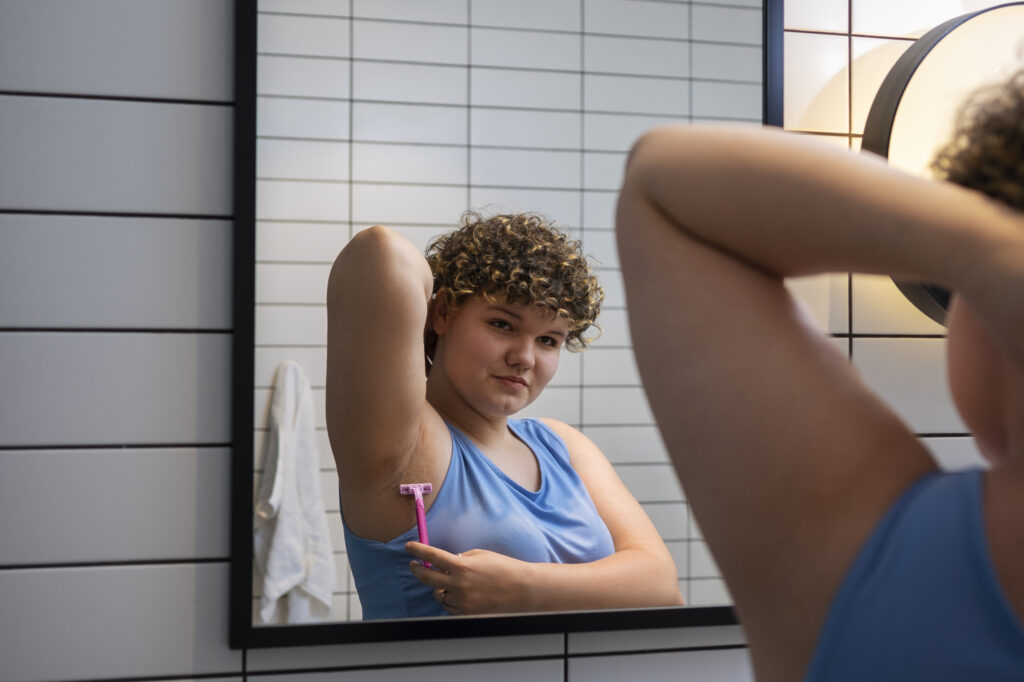
Dealing with underarm razor burn can transform a routine shave into a painful ordeal, leaving skin red, inflamed, and itchy. This guide dives deep into the causes, immediate relief strategies, prevention techniques, and expert-backed solutions to ensure your underarms stay smooth and irritation-free. Whether you’re battling occasional discomfort or chronic irritation, here’s your ultimate roadmap to healing and preventing razor burn.
1. Understanding Underarm Razor Burn: Causes and Risk Factors
Razor burn occurs when shaving damages the skin’s protective barrier. The underarm area is especially prone due to its thin skin, constant friction from movement, and frequent exposure to products like deodorants. Let’s unpack the key culprits:
A. Common Causes
Dull or Old Razors
Blunt blades tug at hairs instead of cutting cleanly, irritating follicles and causing microtears.
Fix: Replace razors every 5–7 shaves or when blades feel rough.
Dry Shaving
Shaving without water or lubricant (e.g., soap, shaving gel) increases friction and strips natural oils.
Fix: Always use a hydrating shaving cream or conditioner.
Shaving Against the Grain
Cutting hair against its growth direction lifts follicles, leading to ingrown hairs and inflammation.
Fix: Shave in the direction of hair growth first, then gently go sideways if needed.
Tight Clothing or Friction
Post-shave friction from tight sleeves or synthetic fabrics traps sweat and bacteria, worsening irritation.
Fix: Wear loose, breathable cotton clothing after shaving.
Harsh Skincare Products
Alcohol-based deodorants, fragranced lotions, or exfoliants can inflame freshly shaved skin.
Fix: Opt for fragrance-free, hypoallergenic products post-shave.
B. Risk Factors for Severe Razor Burn
Sensitive Skin: Genetic predisposition to irritation or conditions like eczema.
Coarse or Curly Hair: More prone to ingrown hairs and folliculitis.
Frequent Shaving: Daily shaving doesn’t give skin time to heal.
2. How to Get Rid of Underarm Razor Burn Fast: 7 Expert-Backed Treatments
If you’re already dealing with a flare-up, these ways to help razor burn will soothe symptoms within hours to days:
A. Immediate Relief Strategies
Cool Compress
How it works: Reduces swelling and numbs pain by constricting blood vessels.
Steps: Soak a washcloth in cold water, wring it out, and press it to the area for 5–10 minutes.
Aloe Vera Gel
Why it works: Contains antioxidants and polysaccharides to calm inflammation and speed healing.
Pro tip: Refrigerate pure aloe gel for an extra cooling effect.
Oatmeal Paste
Benefits: Colloidal oatmeal is FDA-approved to relieve itching and repair skin.
Recipe: Mix 1 tbsp. ground oats with water, apply for 10 minutes, then rinse.
B. Medical-Grade Solutions
Hydrocortisone Cream (1%)
Use case: For severe redness and itching.
Caution: Don’t use longer than 7 days to avoid thinning skin.
Antibacterial Ointments
When to use: If razor burn is accompanied by broken skin or pustules (signs of infection).
Example: Apply a thin layer of Bacitracin.
C. Natural Remedies
Witch Hazel Toner
Benefits: A natural astringent that reduces inflammation and prevents bacterial growth.
Application: Dab onto skin with a cotton pad 1–2 times daily.
Coconut Oil + Tea Tree Oil Blend
Recipe: Mix 1 tbsp. coconut oil with 2 drops tea tree oil.
Why: Coconut oil moisturizes, while tea tree oil fights bacteria (study-backed).
3. Preventing Underarm Burning After Shaving: A 5-Step Routine
Stop razor burn before it starts with these ways to prevent underarm irritation:
A. Pre-Shave Prep
Exfoliate Gently
Method: Use a soft washcloth or chemical exfoliant (e.g., lactic acid) 1–2 times weekly.
Why: Removes dead skin cells that clog razors and cause ingrown hairs.
Hydrate the Skin
Tip: Shave after a warm shower—steam softens hair and opens pores.
B. During Shaving
Use a Sharp, Single-Blade Razor
Why multi-blade razors worsen irritation: Multiple blades cut hair below skin level, increasing ingrown risk.
Recommended: Safety razors or single-blade disposables like Flamingo.
Apply a Protective Shaving Cream
Best ingredients: Look for aloe vera, shea butter, or oat extract.
Avoid: Products with alcohol, menthol, or sulfates.
C. Post-Shave Care
Moisturize and Soothe
Step 1: Rinse with cool water to close pores.
Step 2: Apply a fragrance-free moisturizer with ceramides (e.g., CeraVe).
Step 3: Wait 30 minutes before applying deodorant.
4. Long-Term Solutions for Chronic Underarm Razor Burn
If you’re still struggling, consider these alternatives to traditional shaving:
A. Hair Removal Alternatives
Electric Razors: Trim hair without touching the skin (e.g., Braun Silk-épil).
Depilatory Creams: Dissolve hair chemically (patch-test first!).
Laser Hair Removal: Reduces hair growth long-term (6–8 sessions needed).
B. Skincare Adjustments
Switch Deodorants: Use aluminum-free, sensitive-skin formulas (e.g., Native, Dove Sensitive).
Nightly Repair: Apply a niacinamide serum to strengthen the skin barrier.
5. When to See a Dermatologist
Consult a professional if:
Razor burn persists for over 2 weeks.
You develop painful cysts, scarring, or signs of infection (yellow pus, fever).
Over-the-counter treatments aren’t working.
6. FAQs: Your Underarm Razor Burn Questions Answered
Q: Can I shave over razor burn?
A: No—shaving inflamed skin will worsen irritation. Let the area heal for 3–5 days first.
Q: Is razor burn the same as folliculitis?
A: No. Folliculitis is a bacterial infection requiring antibiotics, while razor burn is superficial irritation.
Q: Can men get underarm razor burn?
A: Absolutely! Anyone who shaves their underarms is at risk.
Q: Does shaving cream expire?
A: Yes—old creams lose moisture and may harbor bacteria. Replace every 6–12 months.
7. Pro Tips from Dermatologists
Dr. Whitney Bowe, MD: “Apply a thin layer of petroleum jelly post-shave to lock in moisture and protect the skin.”
Dr. Hadley King, MD: “Avoid scrubbing the area—gentle patting prevents further damage.”
Conclusion: Embrace Smooth, Bump-Free Underarms
By understanding the root causes of underarm razor burn and implementing these ways to get rid of razor burn, you can transform your shaving routine. Prioritize sharp tools, gentle techniques, and soothing aftercare to keep your skin calm and confident.
Ready to say goodbye to irritation? Share your success story in the comments or tag us in your skincare journey on social media!
